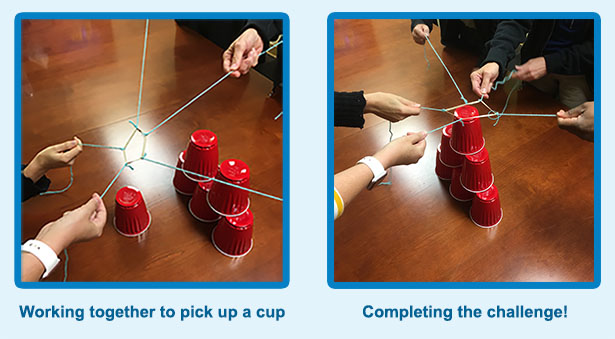- Home
- Free K-2 Science Resources
- Back-to-School Science Activity

Back-to-School Science Activity
Objective
Start the school year with this fun science and team building activity! With just a few rubber bands, cups, and string, you can help your students get to know each other and practice their communication and collaboration skills. Not only does this activity serve as a great back to school icebreaker, but it also illustrates standards-aligned core ideas relating to force and motion, including how pushes and pulls change the speed or direction of an object.

Materials
- Plastic cups
- Rubber bands (large enough to fit around the cups)
- String
- Cut the string into pieces that measure 2-3 feet long, one piece for each student.
- Tie 4-6 pieces of string to each rubber band, spaced equally apart, to create a “rubber band tool.”
How it Works
- Divide the class into small groups of 4-6 students each.
- Give each group 6 cups, and a rubber band tool.
- Explain that students must move the cups from one surface to another without touching them. They can only use the rubber band tool and their words. Every member must participate, with each student in charge of a different piece of string!
- For older students, you can increase the difficulty level by asking them to stack their six cups into a pyramid! You might also take away their ability to speak and challenge them to use nonverbal communication only, or blindfold some members of the group!
- Connect the activity to science by asking questions about how this activity relates to force and motion, including the importance of tension. Point out that each group member must adjust the tension of their string to successfully move the cups!
Reflection
Some groups may complete the task in just ten minutes or so, while others may not finish at all. When you come together post-activity for a class discussion, you can explain to your students that the outcome does not matter as much as what they learned during the activity. Here are some questions you can pose to the group to end the lesson. This reflection piece will help students realize and retain the key lessons of the exercise:
- Were any of you frustrated by this activity? What did you do when you were frustrated? Did you find good ways of dealing with your frustration or overcoming it?
- How did the rubber band and strings affect the cups? What kept the cup steady? What made it move and change direction? What are some scientific terms we can use to describe what we just observed?
- Why was teamwork important for this activity?
- Did any specific roles emerge in your group? Were certain people leaders, others listeners? Do you think it takes a variety of different roles to create an effective team, and that people can take turns playing different roles?
- What did you learn about yourself during this activity? How did you contribute to your group?
- How will you apply what you learned during this activity to other experiences
Related Projects
Want More?
Check out these quick links.
Select a curriculum by grade level